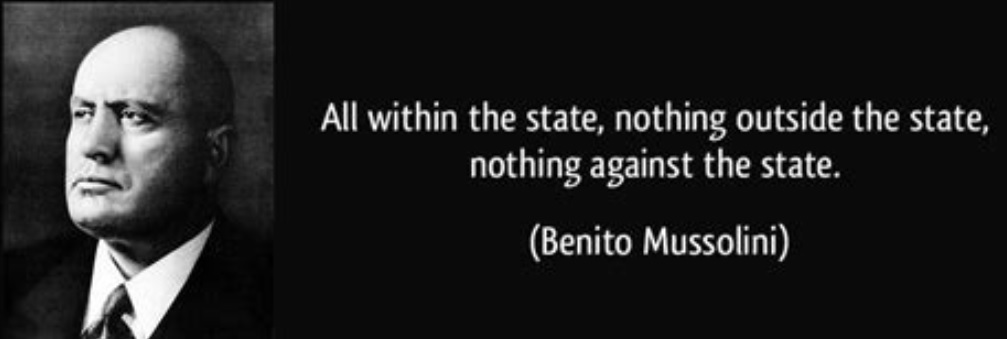Based on Sunday’s election in Italy, the nation’s next Prime Minister almost certainly will be Giorgia Meloni, which has some worried that Italy is returning to the “far right” fascism of Benito Mussolini.
From an economic perspective, though, it would be more accurate to say that Mussolini is “far left.”
Or to say that he is a collectivist, which puts him in the same camp as socialists and communists.
In an article for the Independent Institute, Angelo Codevilla discussed how Mussolini began his career as a socialist activist, but ultimately was forced out of the party because of his nationalist views..
He was active in socialist circles, both Italian and international, giving speeches to workers and helping to organize strikes… He got to know Vladimir Lenin… Benito became a full-time socialist activist…as editor of its socialist newspaper. …he supported himself writing essays and editing a journal called Lotta di classe—class struggle… In 1911 the party entrusted the 28-year-old with editorship of its flagship publication, Avanti!. …He had become Italian socialism’s brightest star. …In…1914…he committed socialist heresy by writing that class struggle is a bad idea because the nation is more important than social class. He called his few scattered followers fasci, bundles, of individuals. …Hence he labeled the movement “Fasci Rivoluzionari d’Azione Internazionalista” and its members “Fascisti.” …the party expelled him.
In other words, Mussolini was part of the conflict between “national socialism” and “international socialism.”
Both versions of socialism favored big government, but they differed in how they viewed the nation state.
And this conflict, driven in part by the events of World War I, led Mussolini to develop fascism as a distinct strain of statism.
…continuing to call himself a socialist and propagandizing his evolving blend of nationalism and socialism…Mussolini shifted to building fascism into a party. …Hegel, following Napoleon, had made patriotic worship of the scientifically administered, progressive state the political essence of modernity. Mussolini’s vision of Italy followed from that. “The bureaucracy is the state,” he said. …Mussolini explained, …The state personifies the country, and disciplines its several elements to its service. “Soon, we will be the state.”
And he was right, at least in the sense that he and his fascists soon took over the government.
In the 1921 elections, Mussolini’s Fascists had gained only .04% of the vote. But chaos reigned in the streets because of socialist, Communist, and anarchist mobs, as well as because of the perhaps 40,000 fascist squadristi (the Blackshirts) who fought them.
…Mussolini organized the descent of some 30,000 squadristi on Rome to demand he be named prime minister. …the king appointed Mussolini to head a government with almost no fascists. But…Mussolini gradually dispossessed the rest. …Fascist Italy was the first country in which the elected legislature gave up its essential powers to the executive…thus establishing the modern administrative state. …
Socioeconomic organization was fascism’s defining feature. Only employers’ and employees’ organizations approved by the government were allowed. …No longer would corporations be responsible to owners.
Mussolini’s fascism was different than traditional socialism in that the goal was to have the government control the economy, but not to have government take over “the means of production.”
Both approaches were very hostile to free markets, of course.
I’ll close with some excerpts about Italian fascism and FDR’s failed New Deal.
After Franklin Roosevelt’s inauguration in 1933, Mussolini’s enthusiasm for likening the New Deal to fascism’s political-economic order… he made clear that “the spirit of [FDR’s program] resembles fascism’s since, having recognized that the state is responsible for the people’s economic well-being, it no longer allows economic forces to run according to their own nature.”
…Fascists rejoiced that FDR had forsaken liberal for corporativist principles… It could hardly have been otherwise since the essence of the National Industrial Recovery Act—the involuntary inclusion of all participants in categories of economic activity and their subjection to government-dictated prices, wages, and working conditions—was at least as detailed as those in fascism’s corporate law.
Since I’ve written about how the New Deal (and much of modern leftism) is based on fascist economics, I obviously agree.
But I’ve also explained that it’s better to refer to such policies as corporatist or interventionist since fascism nowadays also implies support for some of Hitler’s lunatic ideas about race and conquest.
P.S. The main message of today’s column is that it’s silly to label Mussolini (and his political heirs) as being on the far right. But it’s also true that Mussolini’s nationalist approach to statism is different than the ideas advocated by Marx (and his political heirs).
Dissecting and explaining these differences is why I think the left-right ideological spectrum should be replaced by this triangle.
By the way, the top of the triangle could say “Classical Liberalism,” but I used “Libertarian” so American readers would easily understand.
P.P.S. There’s a “Political Compass Test” that does a good job of determining one’s philosophical orientation, but it completely botches where Mussolini belongs.


No comments:
Post a Comment